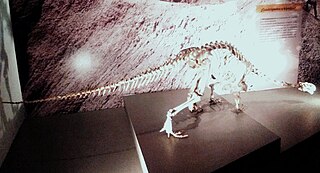 W
WAdeopapposaurus is a genus of prosauropod dinosaur from the Early Jurassic Cañón del Colorado Formation of San Juan, Argentina. It was similar to Massospondylus. Four partial skeletons with two partial skulls are known.
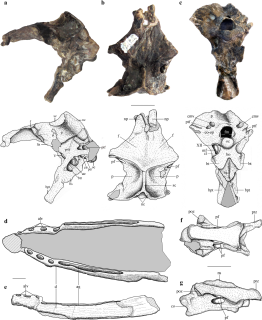 W
WAllkaruen is a genus of "rhamphorhynchoid" pterosaur from the Early-to-Middle Jurassic Cañadon Asfalto Formation in Argentina. It contains a single species, A. koi.
 W
WAmygdalodon was a genus of basal sauropod from the Middle Jurassic of Argentina. The type species is Amygdalodon patagonicus. Fossils of Amygdalodon have been found in the Toarcian Cerro Carnerero Formation of the Jurassic. Very little is known about it, but it is one of the few Jurassic dinosaurs from South America found thus far.
 W
WAraucaria mirabilis is an extinct species of coniferous tree from Patagonia, Argentina. It belongs to the section Bunya of the genus Araucaria.
 W
WAraucarites sanctaecrucis is an extinct coniferous tree from Patagonia, Argentina. Its exact affinities are unknown and it is currently assigned to the form genus Araucarites of the family Araucariaceae. A. sanctaecrucis are known from petrified fossils of branches, foliage, and cones from the Cerro Cuadrado Petrified Forest.
 W
WAsfaltovenator is a genus of basal tetanuran, possibly allosauroid dinosaur from the Middle Jurassic Cañadón Asfalto Formation from Chubut Province, Argentina. The type and only species is Asfaltovenator vialidadi.
 W
WAspidoceras is an extinct ammonoid cephalopod genus belonging to the family Aspidoceratidae.
 W
WBerriasella is a discoidal evolute perisphinctacean ammonite, and type genus for the neocomitid subfamily Berriasellinae. Its ribbing is distinct, consisting of both simple and bifurcated ribs that extend from the umbilical seam across the venter; its whorl section generally compressed, the venter more or less narrowly rounded.
 W
WBrachyphyllum is a form genus of fossil coniferous plant foliage. Plants of the genus have been variously assigned to several different conifer groups including Araucariaceae and Cheirolepidiaceae. They are known from around the globe from the Late Carboniferous to the Late Cretaceous periods.
 W
WBrachytrachelopan is a short-necked sauropod dinosaur from the Late Jurassic of Argentina. The holotype and only known specimen was collected from an erosional exposure of fluvial sandstone within the Cañadón Calcáreo Formation on a hill approximately 25 kilometres (16 mi) north-northeast of Cerro Cóndor, Chubut Province, in west-central Argentina, South America. Though very incomplete, the skeletal elements recovered were found in articulation and include eight cervical, twelve dorsal, and three sacral vertebrae, as well as proximal portions of the posterior cervical ribs and all the dorsal ribs, the distal end of the left femur, the proximal end of the left tibia, and the right ilium. Much of the specimen was probably lost to erosion many years before its discovery. The type species is Brachytrachelopan mesai. The specific name honours Daniel Mesa, a local shepherd who discovered the specimen while searching for lost sheep. The genus name translates as "short-necked Pan", Pan being the god of the shepherds.
 W
WThe Cañadón Calcáreo Formation is an Oxfordian to Kimmeridgian-aged geologic formation, from the Cañadón Asfalto Basin in Chubut Province, Argentina, a rift basin that started forming since the earliest Jurassic. It was formerly thought to date into the Cretaceous, but the age has been revised with Uranium Lead dating as likely being solely Late Jurassic in age.
 W
WThe Canon del Colorado Formation is an Early Jurassic geologic formation in the San Juan Province of Argentina. The formation comprises conglomerates and claystones and is exposed in the Sierra de Mogna. Dinosaur remains are among the fossils that have been recovered from the formation; Adeopapposaurus.
 W
WCaypullisaurus is an extinct genus of large platypterygiine ophthalmosaurid ichthyosaur from the Late Jurassic to the Early Cretaceous of Argentina. Its holotype was collected from the Vaca Muerta Formation of Cerro Lotena, Neuquen, dating to the early Tithonian stage of the Late Jurassic, about 150 million years ago. Caypullisaurus was first named by Marta Fernández in 1997 and the type species is Caypullisaurus bonapartei. It is a member of the family Ophthalmosauridae, and closely related to Platypterygius and Brachypterygius. In 2012, Caypullisaurus was found to be most closely related to Athabascasaurus and "Platypterygius" australis, and to nest within the subfamily Platypterygiinae.
 W
WThe Cerro Carnerero Formation is a geological formation of the Golfo San Jorge Basin in Chubut Province, Patagonia, Argentina.
 W
WChacaicosaurus is an extinct genus of long-snouted thunnosaur ichthyosaur known from the northwestern Patagonia area of Argentina.
 W
WThe Chon Aike Formation is an extensive geological formation, present in the Deseado Massif in north-central Santa Cruz Province, Patagonia, Argentina. It covers an area of approximately 100,000 square kilometres (39,000 sq mi) and consists of rhyolitic volcanic rocks, particularly ignimbrites and lavas, with smaller amounts of agglomerates and tuffs. Within dacitic rocks, plant fossils have been found.
 W
WCladophlebis is an extinct form genus of fern, used to refer to Paleozoic and Mesozoic fern leaves that have "fern fronds with pinnules that are attached to the rachis, and have a median vein that runs to the apex of the pinnule, and veins from that are curved and dichotomise". By convention this genus is not used to refer to fossil ferns from the Cenozoic. Ferns with this morphology belong to several families, including Osmundaceae, Dicksoniaceae and Schizaeaceae. Ferns with this morphology are common during the Paleozoic and Mesozoic in both the northern and southern hemispheres.
 W
WCondorraptor is a genus of megalosauroid theropod dinosaur. Its genus name means 'robber from Cerro Condor', referencing a nearby village, while its species name, currumili, is named after Hipolito Currumil, the landowner and discoverer of the locality. It was among the earliest large South American theropods, having been found in Middle Jurassic strata of the Cañadón Asfalto Formation in the Cañadón Asfalto Basin of Argentina. The type species, described in 2005, is Condorraptor currumili. It is based on a tibia, with an associated partial skeleton that may belong to the same individual. Initially described as a basal tetanuran, Benson (2010) found it to be a piatnitzkysaurid megalosauroid and the sister taxon of Piatnitzkysaurus, a finding supported by later studies.
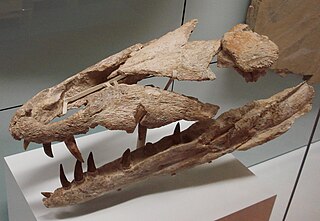 W
WDakosaurus is an extinct genus within the family Metriorhynchidae that lived during the Late Jurassic and Early Cretaceous. It was large, with teeth that were serrated and compressed lateromedially. The genus was established by Friedrich August von Quenstedt in 1856 for an isolated tooth named Geosaurus maximus by Plieninger. Dakosaurus was a carnivore that spent much, if not all, its life out at sea. The extent of its adaptation to a marine lifestyle means that it is most likely that it mated at sea, but since no eggs or nests have been discovered that have been referred to Dakosaurus, whether it gave birth to live young at sea like dolphins and ichthyosaurs or came ashore like turtles is not known. The name Dakosaurus means "biter lizard", and is derived from the Greek dakos ("biter") and σαῦρος -sauros ("lizard").
 W
WEoabelisaurus is a genus of abelisaurid theropod dinosaur from the Middle Jurassic Cañadón Asfalto Formation of the Cañadón Asfalto Basin in Argentina, South America. The generic name combines a Greek ἠώς, (eos), "dawn", with the name Abelisaurus, in reference to the fact it represents an early relative of the latter. Only one species is currently recognized, E. mefi, from which the specific name honours the MEF, the Museo Paleontológico "Egidio Feruglio", where discoverer Diego Pol is active. It is characterized by reduced forelimb proportions that show primitive characteristics of the Abelisauridae family.
 W
WGeosaurus is an extinct genus of marine crocodyliform within the family Metriorhynchidae, that lived during the Late Jurassic and the Early Cretaceous. Geosaurus was a carnivore that spent much, if not all, its life out at sea. No Geosaurus eggs or nests have been discovered, so little is known of the reptile's lifecycle, unlike other large marine reptiles of the Mesozoic, such as plesiosaurs or ichthyosaurs which are known to give birth to live young out at sea. Where Geosaurus mated, whether on land or at sea, is currently unknown. The name Geosaurus means "Mother of Giants lizard", and is derived from the Greek Ge- and σαῦρος -sauros ("lizard"). The name Geosaurus was established by the French naturalist Georges Cuvier in 1824.
 W
WHarpoceras is an extinct genus of cephalopod belonging to the family Hildoceratidae. These cephalopods existed in the Jurassic period, during Toarcian age from Falciferum zone to Commune subzone of Bifrons zone. They were fast-moving nektonic carnivores.
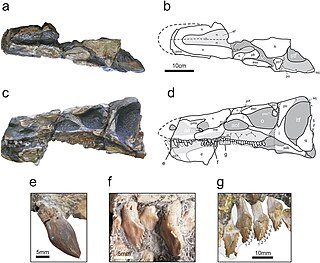 W
WIsaberrysaura is a genus of stegosaurian ornithischian dinosaur from the Early Jurassic Los Molles Formation of Patagonia, Argentina. The genus contains a single species, I. mollensis, described by Salgado et al. in 2017 from a single specimen. Although initially classified as a basal neornithischian, subsequent analysis has allied it with the Stegosauria; the morphology of its skull resembles those of other members of the group.
 W
WIsastrea is an extinct genus of corals that lived during the Jurassic and Cretaceous periods. Its fossils have been found in Europe, Africa, North America, Asia and South America.
 W
WLeonerasaurus is a basal genus of sauropodomorph dinosaur. Currently, there is only one species known, named L. taquetrensis by Diego Pol, Alberto Garrido and Ignacio A. Cerda in 2011. The fossil, an incomplete subadult individual, was found in the Las Leoneras Formation in Argentina. This formation is probably Early Jurassic in age. Leonerasaurus was a small non-sauropod sauropodomorph, showing an unusual combination of basal and derived characters. This indicates that the evolution of early sauropodomorphs witnessed a great degree of convergent evolution.
 W
WLeyesaurus is an extinct genus of massospondylid sauropodomorph dinosaur known from the San Juan Province, northwestern Argentina.
 W
WThe Los Molles Formation is a geologic formation of Early to Middle Jurassic age, located at northern and central part of Neuquén Basin at Mendoza Shelf in Argentina. It is overlain by the Niyeu–Lajas Formation.
 W
WThe Lotena Formation is a geologic formation dated from the Late Callovian to Early Oxfordian in the Neuquén Basin in Mendoza Province, Argentina. The formation, first defined by Weaver in 1931 and named after Cerro Lotena, consists of fluvial conglomerates, calcareous sandstones and marine limestones and shales. The Lotena Formation is overlain by the La Manga Formation and overlies the Lajas Formation of the Cuyo Group. Initially, the fossil find of the pterosaur Herbstosaurus pigmaeus was reported from the formation, but this fossil was found in the younger Vaca Muerta. The formation is a reservoir rock in the Neuquén Basin.
 W
WManidens is a genus of heterodontosaurid dinosaur from the Middle Jurassic of Patagonia. Fossils have been found in the Cañadón Asfalto Formation in Chubut Province, Argentina, dating to the Bajocian.
 W
WLa Matilde Formation is a Jurassic geological formation in the Austral Basin of Santa Cruz Province, Patagonia, Argentina. It is dated to the Middle to Late Jurassic. From the Bathonian age to the Kimmeridgian age at the latest.
 W
WNacientes del Biobío Formation is a geological formation that crops out near the uppermost reaches of Bío Bío River, in south-central Chile, and nearby areas of Argentina. The formation is made up of basalt and pyroclastic rocks and marine sedimentary rocks, such as sandstone and mudstone. Some less abundant sedimentary lithologies are conglomerate, volcaniclastic sedimentary rock. The formation is intruded by Grupo Plutónico Galletué which is of Late Jurassic to Late Cretaceous age. Further north in Chile the formation is similar to Nacientes del Teno Formation while in Argentina it is similar to Los Molles Formation and Lotena Formation.
 W
WNotobatrachus is an extinct genus of frog from the Middle Jurassic Cañadon Asfalto Formation, Cañadón Asfalto Basin and La Matilde Formation, Deseado Massif of Patagonia, Argentina. N. degiustoi is the most completely known Jurassic frog and has been recorded in many outcrops of the La Matilde Formation of the Deseado Massif in southern Patagonia.
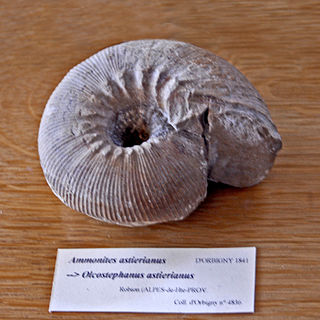 W
WOlcostephanus is an extinct ammonoid cephalopod genus belonging to the family Olcostephanidae. These fast-moving nektonic carnivores lived during the Cretaceous, from the upper Valanginian to the lower Hauterivian age.
 W
WOphthalmosaurus is an ichthyosaur of the Middle Jurassic period, named for its extremely large eyes. It had a graceful 6 m (19.5 ft) long dolphin-shaped body, and its almost toothless jaw was well adapted for catching squid. Major fossil finds of this genus have been recorded in Europe and North and South America.
 W
WPatagosaurus is an extinct genus of eusauropodan dinosaur from the Middle Jurassic of Patagonia, Argentina. It was first found in deposits of the Cañadón Asfalto Formation, which date to around 165 to 161 million years ago. Although originally twelve specimens were assigned to the taxon, at least one of them may belong to a different genus. Patagosaurus probably lived alongside genera as Piatnitzkysaurus, Condorraptor, and Volkheimeria.
 W
WPerisphinctes is an extinct genus of ammonite cephalopod. They lived during the Middle to Late Jurassic epochs and serve as an index fossil for that time period. The species P. boweni was named after the English chemist and geologist E. J. Bowen (1898–1980).
 W
WPiatnitzkysaurus is a genus of megalosauroid theropod dinosaur that lived approximately 166 to 164 million years ago during the middle part of the Jurassic Period in what is now Argentina. Piatnitzkysaurus was a moderately large, lightly built, bipedal, ground-dwelling carnivore that could grow up to 6.6 m (21.7 ft) long.
 W
WReineckeia is an extinct genus of ammonoid cephalopods belonging to the family Reineckeiidae.
 W
WSagenopteris is a genus of extinct seed ferns from the Triassic to late Early Cretaceous.
 W
WSagenopteris trapialensis are leaves of extinct species of seed ferns from Chubut, Patagonia Argentina. At the moment, S. trapialensis is based on impression fossils found in the Early Jurassic Lonco Trapial Formation near Paso del Sapo, Chubut Province.
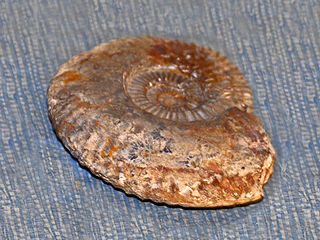 W
WSchlotheimia is a genus of extinct cephalopods belonging to the subclass Ammonoidea that lived during the Hettangian stage at the beginning of the Early Jurassic.
 W
WTehuelchesaurus is a genus of dinosaur. It is named in honor of the Tehuelche people, native to the Argentinian province of Chubut, where it was first found.
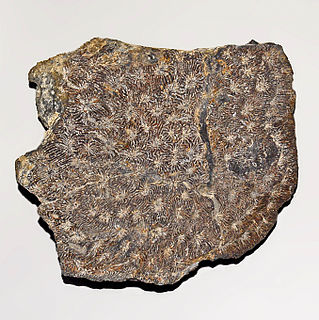 W
WThamnasteria is an genus of extinct stony corals.
 W
WTobífera Formation is a volcano-sedimentary formation of Middle to Late Jurassic age. The formation is crops out in the Magallanes Region in southern Patagonia and Tierra del Fuego of Chile, the Santa Cruz Province of southern Argentina, and in the subsurface of the Malvinas Basin offshore Argentina and the Falkland Islands.
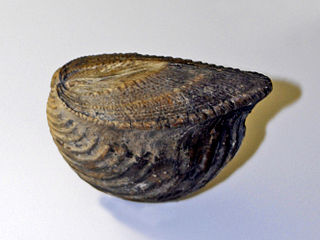 W
WTrigonia is an extinct genus of saltwater clams, fossil marine bivalve mollusk in the family Trigoniidae. The fossil range of the genus spans the Paleozoic, Mesozoic and Paleocene of the Cenozoic, from 298 to 56 Ma.
 W
WUptonia is an extinct ammonite from the Lower Jurassic that's included in the eoderoceratoidean family Polymorphitidae.
 W
WThe Vaca Muerta Formation, commonly known as Vaca Muerta is a geologic formation of Late Jurassic to Early Cretaceous age, located in the Neuquén Basin in northern Patagonia, Argentina. It is well known as the host rock for major deposits of shale oil and shale gas.
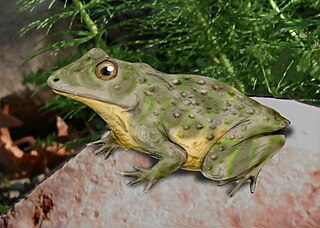 W
WVieraella is an extinct genus of frog from the Jurassic Roca Blanca Formation of Argentina, and the oldest true frog known.
 W
WZamites is a genus of fossil tree known from the Mesozoic of North America, Europe and India through the Eocene of North America. It is a form taxon for leaves that resemble the extant cycad Zamia. The fronds are linear or lanceolate in shape, and pinnately compound, with pinnae with parallel veins and smooth margins, and symmetrical and constricted at the base where they are attached obliquely to the upper surface of the rachis. It has been interpreted as a cycad in the family Cycadaceae or a Bennettitalean plant.